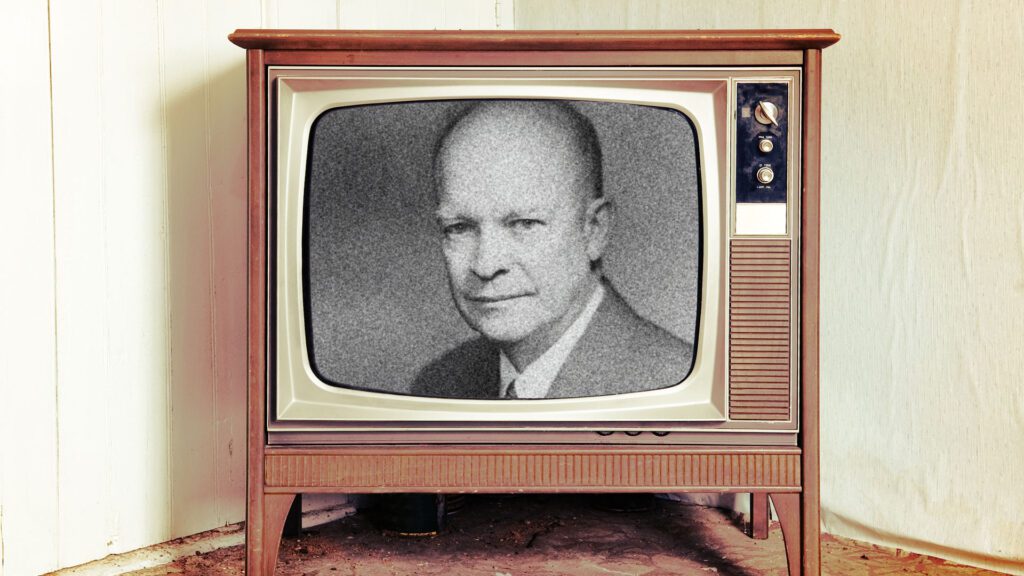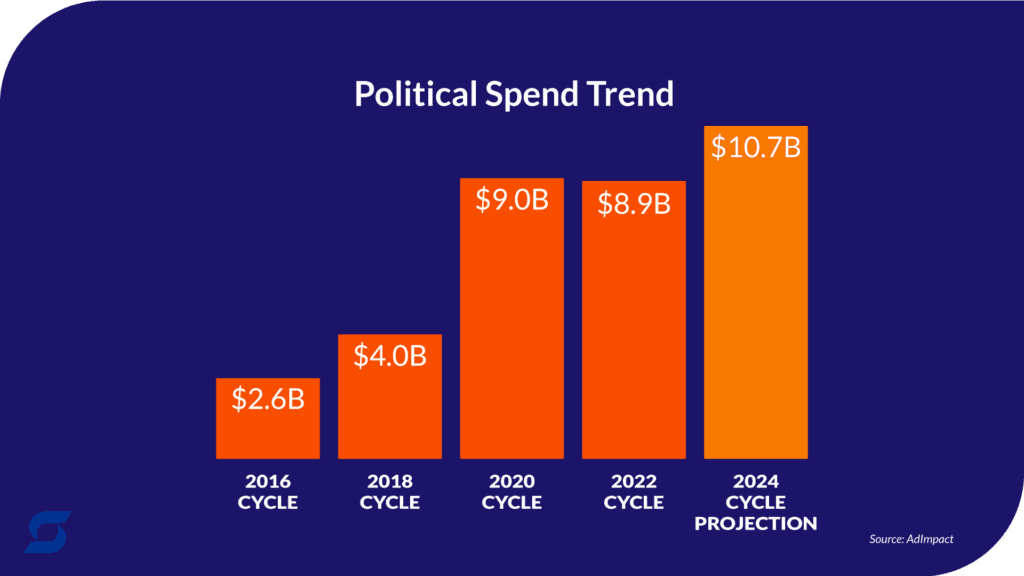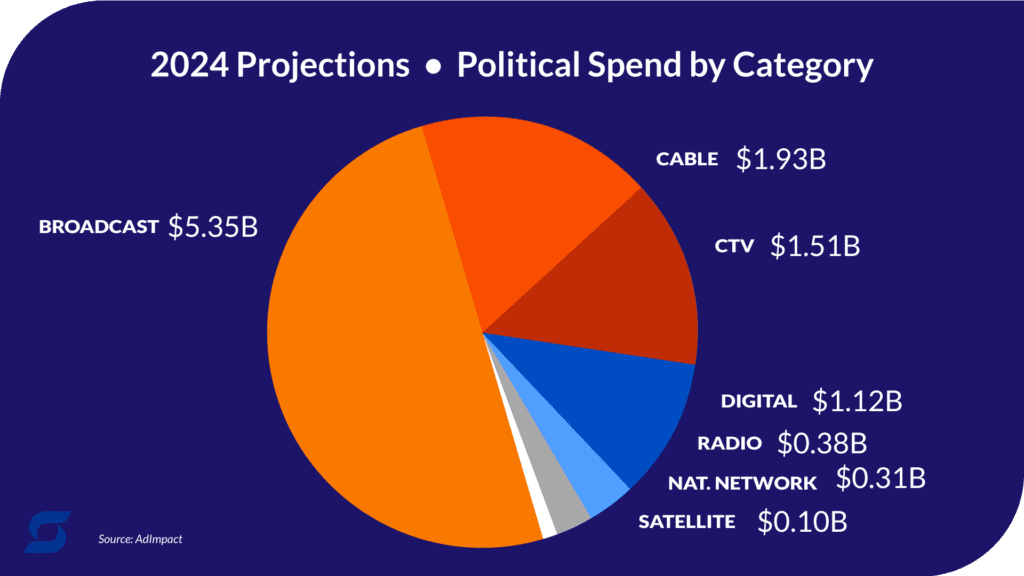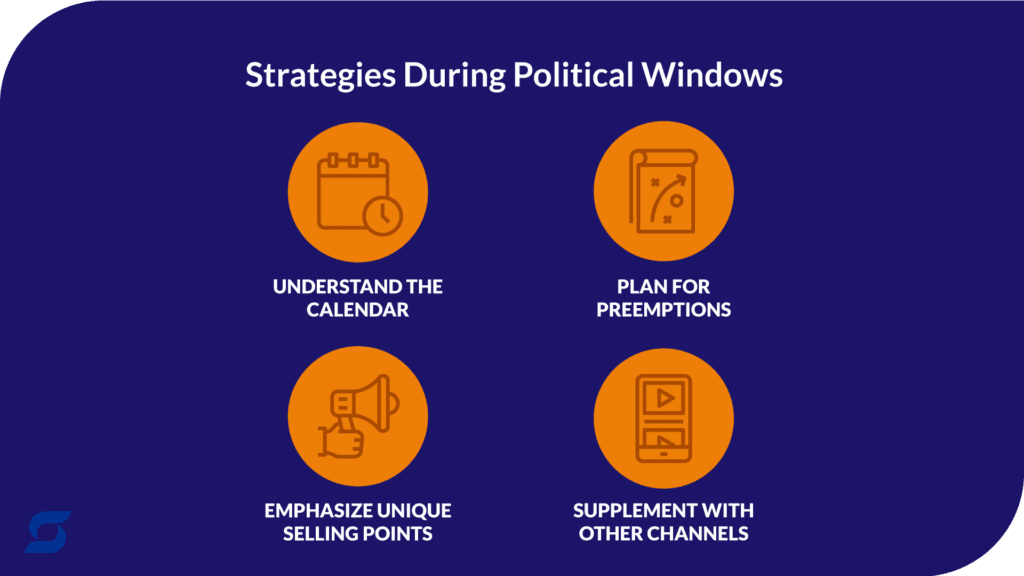As political campaigns become increasingly complex in the United States, traditional TV advertising remains a powerful and influential tool. Despite the significant rise of digital advertising and social media, television continues to be a vital medium for shaping public opinion and mobilizing voters. While traditional linear TV is experiencing a decline in impressions, it still holds substantial relevance in local marketing campaigns.
We’ll explore the dynamics of TV advertising during political elections. Learn the history of political TV advertising, strategies, impact, and the challenges in the modern media landscape.

The Historical Context of TV Advertising in Politics
The intersection of television and political advertising dates back to the mid-20th century, a significant era in political communication. The 1952 presidential election marked the first major use of TV commercials. And it set a precedent for future political campaigns.
Dwight D. Eisenhower’s adept use of TV proved television advertising’s strength. It can convey political messages in an engaging manner, both with visuals and with sound. The impact allowed it to surpass the capabilities of print and radio.
The 1960 presidential debates between John F. Kennedy and Richard Nixon further highlighted TV’s growing influence. Kennedy’s poised and confident TV appearance contrasted sharply with Nixon’s less favorable on-screen presence. It illustrated how television could sway public perception of candidates.
This pivotal moment stressed television’s ability to shape electoral outcomes. It set the stage for its central role in modern political campaigns.
Data and Trends in TV Political Advertising
As previously mentioned, TV remains a dominant force in political campaigns, especially during election years. In the 2020 U.S. presidential election, political ad spending reached a record high of $9 billion (source: Kantar Media). Broadcast ads alone accounted for over $5 billion.
This trend continued in the 2022 midterm elections. Political advertisers spent approximately $3 billion on TV advertising, underscoring the medium’s enduring impact (source: AdImpact).
However, while traditional TV ads continue to hold significant sway, there’s a noticeable shift towards integrating TV and digital strategies. Campaigns are increasingly utilizing Connected TV (CTV) to target younger, more digitally engaged demographics. They’re blending the broad reach of traditional TV with the precision targeting capabilities of digital platforms. This trend is expected to grow, with CTV advertising spend projected to reach $2.7 billion in the 2024 election (source: eMarketer).
The Advantage of Lowest Unit Rate During Political Windows
One key TV advertising advantage for political campaigns is the “lowest unit rate” (LUR) regulation, established by the FCC. The LUR mandates that local TV stations offer political advertisers their lowest available rates during designated windows. Those political windows are 45 days before a primary election and 60 days before the general election.
This regulation aims to ensure fair access to advertising and prevent price gouging. It thus levels the playing field in competitive races. However, the LUR rule does not apply to Political Action Committee (PAC) or Issue advertising. Stations can set their own rates for these types of ads, leading to potential changes in costs.
During election periods, presidential campaigns often focus their ad spending on swing states. They often avoid markets where outcomes are more predictable. In the current cycle, Kamala Harris and Donald Trump are concentrating TV ads in select battleground states to maximize impact.
Local Senate and Governor races also benefit from LUR protection, which can influence both primary and general election dynamics. As a result of heightened demand from political campaigns, local TV advertisers might encounter some speed bumps. They might see increased ad rates and more frequent preemptions when marketing during an election.
To navigate these challenges, local advertisers should plan their ad campaigns around election cycles. Securing inventory in advance or exploring alternative advertising channels during peak political periods can help you stay ahead.
Ad Fatigue and Viewer Impact
Election years often lead to an overload of political messaging, which can result in “ad fatigue” among viewers. Studies show that repetitive exposure to political ads can cause viewers to become desensitized or less engaged. Viewers can even develop negative perceptions of the advertisers.
For non-political advertisers, this presents a challenge. How do you maintain viewer engagement in a crowded and often polarizing ad environment? In extreme cases with very heavy political ad usage, it can even impact viewership.
To counteract ad fatigue, non-political advertisers should focus on standing out from political clutter. High-impact creative that leverages humor, emotional storytelling, or unique selling propositions captures audience attention and maintains engagement, even during peak political ad seasons.
Strategies for Non-Political Advertisers During Political Windows
During election seasons, the growth of political ads can disrupt the media landscape, posing challenges for non-political advertisers. To maintain visibility and effectiveness, non-political advertisers must be creative in their marketing strategies. Here are some approaches to consider:
Understand the Political Advertising Calendar
Awareness of the political advertising schedule can help non-political advertisers avoid price hikes and ad preemptions. Negotiate rates in advance or select off-peak times for ad placements to mitigate the impact on your campaigns.
Plan for Preemptions
Political ads can come in without much warning, leading to preemptions of scheduled ad spots. Local TV advertisers should have contingency plans for reallocating preempted dollars, based on target audience and campaign goals
Emphasize Unique Selling Points
With political television ads ads dominating the airwaves, non-political advertisers must highlight what sets their product apart. Clear, compelling messaging that underscores unique benefits can help capture audience attention amid the clutter.
Supplement with Other Advertising Channels
To counteract the impact of political ad saturation, diversify your advertising strategy. Channels such as radio, CTV, and social media offer valuable opportunities to reach audiences outside the traditional TV landscape. Testing and optimizing these channels can help determine the most effective mix for your campaign.
The Future of TV Political Advertising
The growth of digital media may challenge the dominance of TV advertising. But TV will continue to play a significant role in political campaigns moving forward. Political campaigns are continuing to integrate TV ads with digital strategies to create a more wholistic and engaging voter experience.
Hybrid plans that combine TV with digital platforms will allow campaigns to reach voters through multiple channels. Social media, online video, and targeted digital ads will complement traditional TV efforts, leveraging data-driven approaches to enhance targeting and effectiveness. Innovations in TV advertising, such as interactive ads and advanced analytics will also reshape how we deliver and receive political messages.
The integration of technology and data will lead to more personalized and impactful advertising strategies. It will create new openings for political campaigns to connect with voters. The advertising landscape continues to evolve. Both political and non-political advertisers need to adapt to maximize their impact.
In conclusion, while TV advertising remains a potent tool in the political arena, the landscape is always evolving. By understanding the historical context, using regulatory advantages, and adopting new strategies, advertisers can navigate the challenges of political campaigns. They can continue to reach their target audiences with impact and efficiency, both in the 2024 elections and beyond.
Get in touch to learn more about how Scale Marketing uses insights to drive growth and business results for companies like yours.







